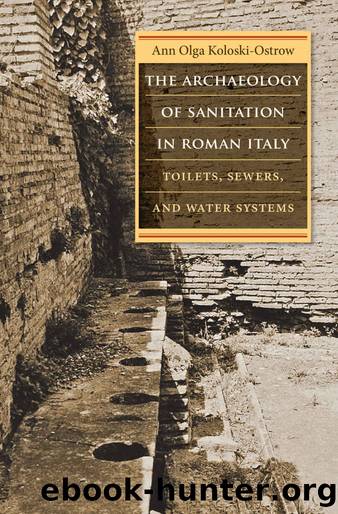The Archaeology of Sanitation in Roman Italy: Toilets, Sewers, and Water Systems (Studies in the History of Greece and Rome) by Ann Olga Koloski-Ostrow

Author:Ann Olga Koloski-Ostrow [Koloski-Ostrow, Ann Olga]
Language: eng
Format: azw
Publisher: The University of North Carolina Press
Published: 2015-04-05T16:00:00+00:00
This passage, perhaps based on a similarly disgusting man from Theophrastusâs Characters, is rich in twisted images of proper table etiquette. The type of personality who would attempt to enliven dinner conversation with an account of his digestive workings is abhorrent and laughable, perfect personal characteristics for the landscape of satirical writing.53
The ungutted hog, the blood puddings, the vomiting bees, Nicerosâs story including a graveyard defecation, Scintilla nearly throwing up after eating bear meat, Habinnasâs comments about women âpissing awayâ money, Daedalusâs pig creations, and Trimalchioâs warning to âcrappersâ on his tomb, keep the metaphor ever before our senses. The dinner ends with Encolpius and his friends rushing out amid the utter confusion of a false fire alarm.54 And like the bursting of an unstoppable bowel movement inspired by hours of stuffing oneâs face, no guest can ever leave Trimalchioâs house by the same way he came in.55 The whole house of Trimalchio takes on the hierarchical head-to-bottom metaphor of the city of Rome and its sewers.
By the early second century A.D.,56 Juvenal finally utilizes satire to its full potential to make it seethe and bubble like the most choked-up of sewers.57 In fact, Juvenal informs us58 that one important collection point for the Cloaca Maxima was the Subura, Romeâs impoverished zone of lowlifes, seedy restaurants, and prostitutes. We now start to see where the sewer and its contents fit conceptually into Juvenalâs view of Rome. Juvenal viciously intensifies the fairly straightforward Plautine reference59 to the neighborhood of the Subura. He clearly implies that sewer drains under the Subura were servicing those parts of the city where the filth was most plentiful and most vile, where urine was generated by the constant flow of cheap wine, and where foul excreta were created from the poor quality of the food to be found in the neighborhood.
In the context of this study, it is not so important to determine which of these authors is accurate or which details are to be believed.60 What is important is the cumulative effect we can glean from our sample, which turns out to demonstrate the literary use of lively, textured imagery regarding toilet habits, latrines, and sewers in the lives of the Romans, sometimes with political overtones. We have let the Romans speak for themselves about sanitation and some of its technologies, such as sewers and latrines. We must be aware that individual authors, like many nineteenth-century writers on the same subject, often speak in double tongues. Given the nature of the literary evidence we have, we must accept and even expect the constant presence of exaggeration and hyperbole in the interest of humorous effect or cutting sarcasm. Nevertheless, the citations we have been discussing from Roman literature show recognition of the sordid nature of excretory matters and, certainly in satire, make a close connection between sewers, their contents, and insults.
Download
This site does not store any files on its server. We only index and link to content provided by other sites. Please contact the content providers to delete copyright contents if any and email us, we'll remove relevant links or contents immediately.
| Africa | Americas |
| Arctic & Antarctica | Asia |
| Australia & Oceania | Europe |
| Middle East | Russia |
| United States | World |
| Ancient Civilizations | Military |
| Historical Study & Educational Resources |
Magic and Divination in Early Islam by Emilie Savage-Smith;(1194)
Ambition and Desire: The Dangerous Life of Josephine Bonaparte by Kate Williams(1084)
Operation Vengeance: The Astonishing Aerial Ambush That Changed World War II by Dan Hampton(985)
What Really Happened: The Death of Hitler by Robert J. Hutchinson(867)
London in the Twentieth Century by Jerry White(844)
Time of the Magicians by Wolfram Eilenberger(842)
Twilight of the Gods by Ian W. Toll(810)
The Japanese by Christopher Harding(795)
Papillon by Henry Charrière(792)
Lenin: A Biography by Robert Service(777)
The Devil You Know by Charles M. Blow(777)
Twelve Caesars by Mary Beard(764)
Freemasons for Dummies by Hodapp Christopher;(747)
The Churchill Complex by Ian Buruma(729)
Napolean Hill Collection by Napoleon Hill(701)
The Enlightenment by Ritchie Robertson(690)
Henry III by David Carpenter;(685)
Bohemians, Bootleggers, Flappers, and Swells: The Best of Early Vanity Fair by Bohemians Bootleggers Flappers & Swells- The Best of Early Vanity Fair (epub)(679)
The Rise and Triumph of the Modern Self by Unknown(652)
